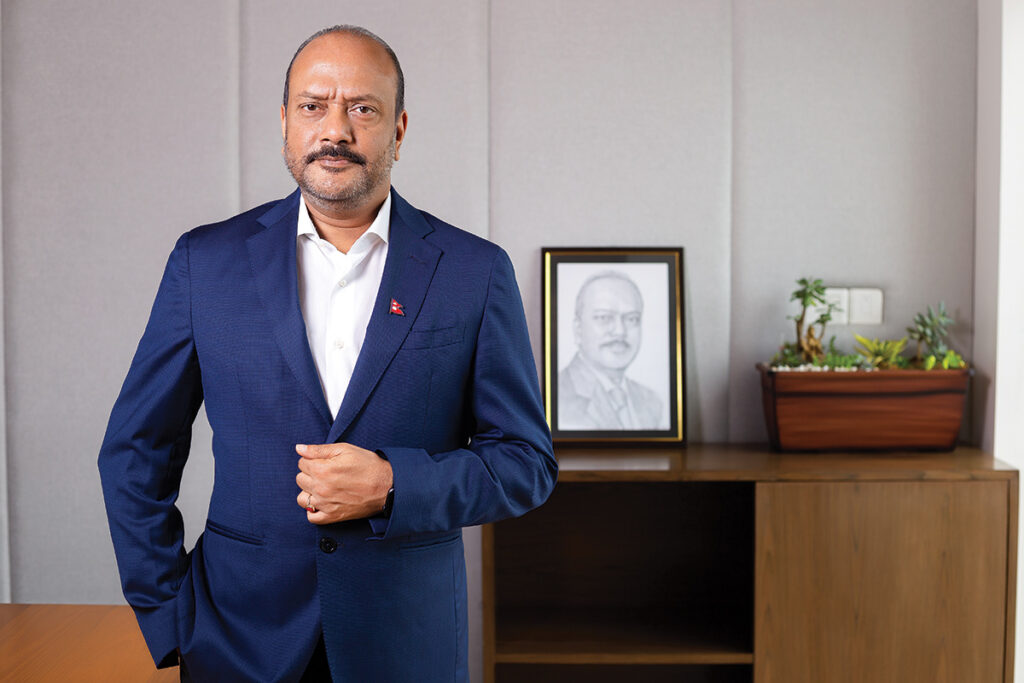
Pawan Golyan is Chairman of the Golyan Group, an established corporate house of the country that carries a legacy of more than six decades with investments in different business verticals like manufacturing, agriculture, tourism, real estate, information technology, financial services and renewable energy. The Golyan Group is backed by a workforce of over 5000 people with a turnover of over $200 million.
Golyan is considered one of the most prominent business leaders of the country. He ardently believes that a strong domestic production base is a must for a sustainable and resilient economy. The current pandemic stands testimony to this fact as Nepal grapples with balance of payment being an import centric economy. Over the years, the industrial policy saw many twists and turns gradually pushing the country towards over-reliance on imports for revenue generation.
Golyan has plans to support the micro, small and medium enterprises (MSMEs) integrating them into the value chain of large scale industries particularly in garment production once the pandemic is over.
In this edition of Business 360, Golyan shares his thoughts on economic transformation with Pushpa Raj Acharya. Excerpts:




The approach of over-dependence on remittances and remittance-fueled imports for robust growth of the economy may not work in the future. We have the reinvent the wheel to spur growth led by domestic production and consumption.
The Corona virus pandemic has posed manifold challenges to the economy. What are your thoughts on economic revival?
The Corona virus pandemic has caused severe setback to the global economy and its revival is a common challenge worldwide. The pandemic has brought a lot of changes and every single country has been working on early revival, however the ways and means can be different. This could be an opportunity for Nepal to change the course of its economy because the earlier way would no longer be able to sustain as job opportunities to labour destinations are shrinking. The approach of over-dependence on remittances and remittance-fueled imports for robust growth of the economy may not work in the future. We have to reinvent the wheel to spur growth led by domestic production and consumption. Despite the fact that remittance is the major source for foreign exchange earnings, a large chunk of that earning goes to India through their people working in Nepal. We are facing challenges of brain drain. We sorely lack a skilled workforce in the country and every youth who comes into the job market is on hunt for foreign job opportunities. In fact, we are losing our human resources. Youth migration for foreign employment has been curtailed to large extent after the pandemic. Against this backdrop, the government should initiate programs for skilling people based on the job market trends. There is huge job opportunity within the country in construction, electrification, plumbing, brick kilns, salons, automobile maintenance among others. Our industry in the Terai region, the Reliance Spinning Mills, is an exception where all employees are cent-percent Nepalis. I am not confident that all employees are Nepalis in our other ventures. It is a common phenomena in the industries in the Terai region to hire mostly Indian nationals as most of them are skilled and they cannot form a trade union inside the industry. Till date, labour unions are a major challenge for industrialists to run their companies smoothly. Personally, I disagree with those who say Nepali workers are indisciplined and not competitive in terms of their productivity. For Reliance Spinning Mills, both discipline and productivity are high. We work to make labour-employer relations cordial. The government has announced different programs for skilling people; if we are able to meet the demand of the Nepali job market, this will be a big achievement indeed.Are you saying that lack of skilled workforce is the only hindrance for Nepal to move towards industrialisation?
I am not saying lack of skill is the only cause. There are multiple reasons but we have to start primarily with creating a skilled workforce suitable to the market needs. When people can get job opportunities within the country, the outflow will be minimised. Secondly, those who have the skills can also embrace entrepreneurship as access to capital is now streamlined through the Monetary Policy 2020-21. In a bid to engage entrepreneurship, large scale industries can integrate small entrepreneurs’ products and services into the value chain. I would like to cite the example of our ‘Mato’ brand. We are selling agricultural produce of small hold farmers in Jhapa district. Farmers are now encouraged to produce more as they are linked with us. They are fetching better price for their products. We are also selling products like masks and sanitizers produced by micro and small manufacturers labeled under our brand. We are selling these products with very marginal profit. If every corporate house does some hand-holding like this, it will definitely provide an opportunity for MSMEs to flourish. The country’s economy will expand in an inclusive, sustainable and resilient manner. This is completely a public private partnership model in developing entrepreneurship, and this is a proven and tested model to sustain enterprises, create employment and expand the production base.
Major drawbacks of Nepal’s development challenge lies in implementation. The government has everything in place in terms of planning and announcements, however the implementing machinery is weak. Until and unless the government improves its capacity of execution machineries, we cannot expect better results or the intended interventions.
Could you define the execution challenges of the PPP model in entrepreneurship development?
Major drawbacks of Nepal’s development challenge lies in implementation. The government has everything in place in terms of planning and announcements, however the implementing machinery is weak. Until and unless the government improves its capacity of execution machineries, we cannot expect better results or the intended interventions. We can do a lot from the PPP model. It is probably the best model for the country’s economic development. The government and the private sector should be equally responsible to make PPP successful. For instance, if the government initiates skilling people, the private sector should guarantee employment opportunities for them or provide some handholding for those who want to embrace entrepreneurship after obtaining the required skills. Value chain integration could be an effective way for large scale industries because cost of production (labour, electricity among others) is highest in South Asia. Perhaps it is also possible to consider bringing down the cost of doing business in the gestation period for new startups and fledging businesses such as providing cheaper electricity, access to trainings, mentoring and certain handholding to lower the cost of production. We are not saying that the government should provide lifelong support to these industries. In fact if any industry seeks lifelong support, we can simply understand that they are not sustainable.What are the high growth potential enterprises in the context of Nepal?
As President of Nepal Exporters Association, I am involved in the consultation with the Ministry of Industry, Commerce and Supplies during the preparation of identification of two dozen products in which the country can be self-reliant. We can be competitive and self-reliant in agricultural products. We should have a comprehensive plan to develop agriculture and non-timber forest products (medicinal and aromatic plants). We are importing tomato sauce worth Rs one billion every year, potato chips, bhujiya, dalmot are being imported more than Rs 5 billion per annum. Similarly, dairy whitener is a single product being imported around Rs 5 billion every year. Likewise, we import cheese, butter, biscuits, chocolates, livestock and many more primary and processed items which can be produced here itself. We will develop strong backward and forward linkages, and many ancillary industries will develop once we move towards becoming self-reliant in products with potential. Nepal has been moving rapidly in the development of hydroelectricity, transmission lines, and now there is prospect of producing cables and conductors within the country. If the government formulates a policy for the mandatory use of domestic cables and conductors, the country can invite large scale investment into the cable and conductor industry. Apart from this, the country has its own unique products, like allo (nettle), handmade paper, handicrafts and other niche market advantage products if we can organise them. We are importing wood and wooden furniture amounting to Rs 100 billion each year despite having the potential to manage timber from our own production. There is enough timber and medicinal and aromatic plants in Karnali and Sudur Paschim Province which can transform the economic situation of these two provinces. I do not mean for the government to invest but for it to create a favourable environment to foster the private sector investment into these areas.The government and policy makers understand the potential of agriculture and agro-processing industries in the country. You are involved in agriculture production and value chain development. Could you share your experience and what are the major challenges for the commercial development of agriculture in Nepal?
We do not have infrastructure to facilitate and attract investment in the agriculture sector. We have faced huge losses as we could not sell the products because of the nationwide lockdown. A major lacking is also data on consumption and production. All data currently available seems to be maintained on ad-hoc basis. We don’t even have database of land ownership, dependents, working age members in a family and their occupation apart from agriculture. All these can be easily prioritised by the local government. I am now wondering how the government will distribute identity cards for the ultra-poor and vulnerable farmers without a data base. The first step should be management of database through local governments. This way the government can deliver services to target groups through Agriculture Coordination Unit of the local government. The Unit should comprise of the mayor or deputy mayor, ward chairs, farmers and other stakeholders for collective ownership. Agriculture inputs such as thresher, tractor, fertilizers, improved seeds among others and extension services can be provided through this mechanism. This machinery will regulate pesticide and recommend high-quality seeds and crops for better output. Secondly, there should be a collection center where the farmers can store their products and sell to buyers. SMEs or corporates can be involved in processing and marketing of the products in coordination with the aforesaid mechanism of the local government. Farmers can fetch better prices through sorting and grading of their products before selling it to the buyers. Based on the production of the crops, SMEs can be set up based on viability. For instance, if there is massive scale of tomato production, a tomato ketchup industry could set up or a potato chip factory can be established where potato production is massive. It is pity that we are not even producing the brooms and dish scrubbers that can be easily produced at competitive rates in the country. Each local government can execute this idea and create employment, raise income level of their people and translate the vision of the development. Thirdly, provinces can develop agro processing zones to invite high-tech, large scale as well as medium scale industries. There can build cold and dry storage facilities to store agro products bought by the government from farmers. The government should buy the products from the farmers if they are not be able to sell and store it in the agro processing zone where industries are located and can supply to them based on their demand or even sell the produce under its own brand. Lastly, the government should develop large agriculture markets in major cities and towns to facilitate consumers and sellers. In addition to this, for the execution of the entire concept, plan, policies, grievance handling and high-level monitoring mechanisms comprising of the agriculture minister from the federal level, chief minister and concerned ministers of each province and mayors and chairman of each municipality and rural municipality must be made effective. This will be a perfect PPP model for agriculture commercialisation and SME growth.
Golyan Group has framed its investment policies based on the needs of the country. We firmly believe that an import-based economy will no longer sustain. If the government does not take corrective actions during this pandemic, we’ll be further pushed into a vicious cycle of sending youth to foreign countries for jobs and supporting import based economy through remittance earnings.
How confident are you that corporates will align their productions with SMEs?
I am confident about this. In Nepal, it is difficult to purchase land to set up industry and develop entire production under one roof of a factory. Electricity and labour cost is high and if the government provides subsidy to the MSMEs in electricity, and access to credit among others, it will be more conducive for corporates to adopt fragmented mode of production. I have seen other corporates like IME Group, IMS Group going to engage in agriculture business. We ourselves are planning to integrate small medium garment producers of seven provinces in our production network. The government should have a comprehensive approach to encourage domestic production in potential areas and provide certain protection to them.Contrary to what you are saying, the fiscal budget and the monetary policy 2020-21 encourages imports. What are your thoughts?
The budget and the monetary policies have not supported domestic industries at par with the facilities provided to imports. The budget has secured profits for authorised dealers and traders of automobiles with the provision of slapping 30% additional duty for other importers. The government often talks about imposing anti-dumping and countervailing duties on imports. It is not so easy for the government who even cannot impose quarantine on imports of fruits and vegetables. The government which has two third majority could not even stand to its decision of seeking sanitary and phytosanitary testing certificates while allowing imported goods into the domestic market. The most important aspect of providing protection and executing quarantine rules comes under the jurisdiction of the Ministry of Commerce worldwide. However, our government is revenue centric and the Ministry of Finance decides with prior consent being required while imposing ban or lifting it on the import of each product. If we give all the power of other ministries to the Ministry of Finance, then we don’t require ministries of industry, commerce, etc. I would like to cite the example of Bangladesh which has agreed to open up its market under free trade agreement against preferential trading agreement from Nepal. However, the Ministry of Finance has put on hold that proposal for almost a year. Being sensitive to revenue, MoF has kept the proposal on hold despite it being beneficial to us as we could then export black cardamom, tea, lentils among others at preferential tariff. Rather than adopting only revenue focused policies, the government should put its whole hearted effort into nation building, creating employment and developing a strong production base in the country. Normally, every government maintains consistency in policies, however the incumbent government has failed in this. The fiscal budget has also scrapped the provision to provide Rs 5 million per MW VAT exemption to power producers. There is also sudden policy changes on power purchase agreement (PPA) of solar and run of the river based generation projects.The government has provided certain incentives for the cement industry and this model is considered quite successful. Can’t the same be applicable to protect domestic industries?
The government has provided 35% tariff protection to the domestic cement industries along with supporting them with grid electricity connection and road access to the mines from the factory site. We can compare the price difference in India and Nepal to observe the level of protection. This approach is necessary for other potential products in the country. There is only 5% protection for textile industries which is not justifiable. The government can expand the revenue controlling all ill practices at the customs like under invoicing, wrong declaration and unauthorised trade. Billing enforcement and control of smuggling will be instrumental in formalising the economy and expanding revenue, and the government can certainly do it. The monetary policy 2020-21 has tried to formalise the economy by arranging subsidised credit for MSMEs. Though the monetary policy has not addressed subsidised credit requirement for corporates and the export sector, but MSMEs can take advantage of it. The government can expand the tax bracket if MSMEs avail subsidised loans.Golyan Group has footprints particularly in priority areas of manufacturing, hydropower, agriculture and recently the Group started a new vertical in tourism through Hyatt Place Hotel. Could you share your plans?
Golyan Group has framed its investment policies based on the needs of the country. We firmly believe that an import-based economy will no longer sustain. If the government does not take corrective actions during this pandemic, we’ll be further pushed into a vicious cycle of sending youth to foreign countries for jobs and supporting import based economy through remittance earnings. The Golyan Group is planning to expand our verticals. We have started manufacturing silpaulin for tunnel farming. We are also planning to expand the spinning mills in Biratnagar and establish backward linkages by promoting farmers in cotton farming. We will massively go into value chain integration of organic agriculture products in the coming days.
Published Date: September 14, 2020, 12:00 am
Post Comments
E-Magazine
RELATED In the Lead


-1749018895.jpg)
-1744691535.jpg)